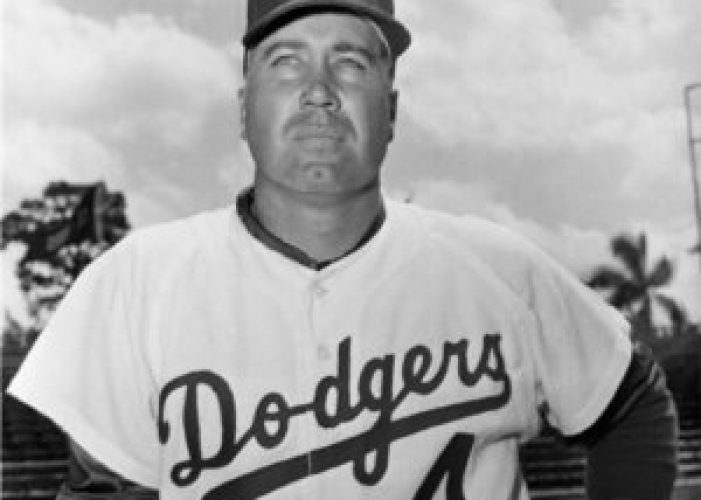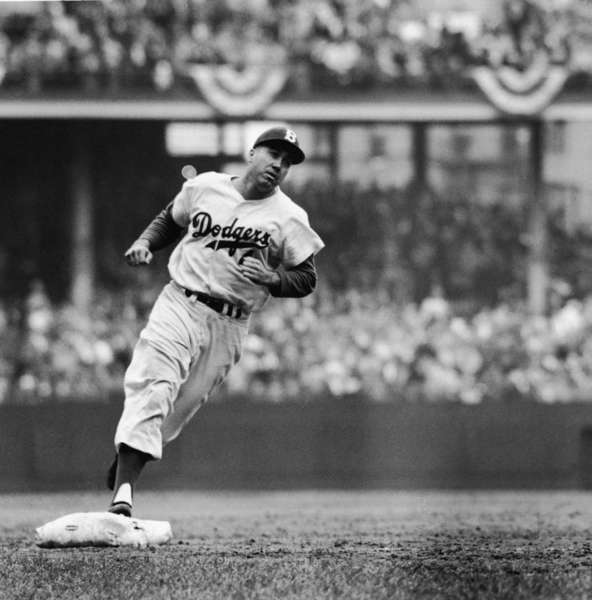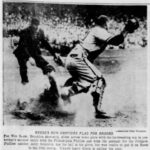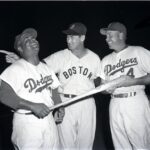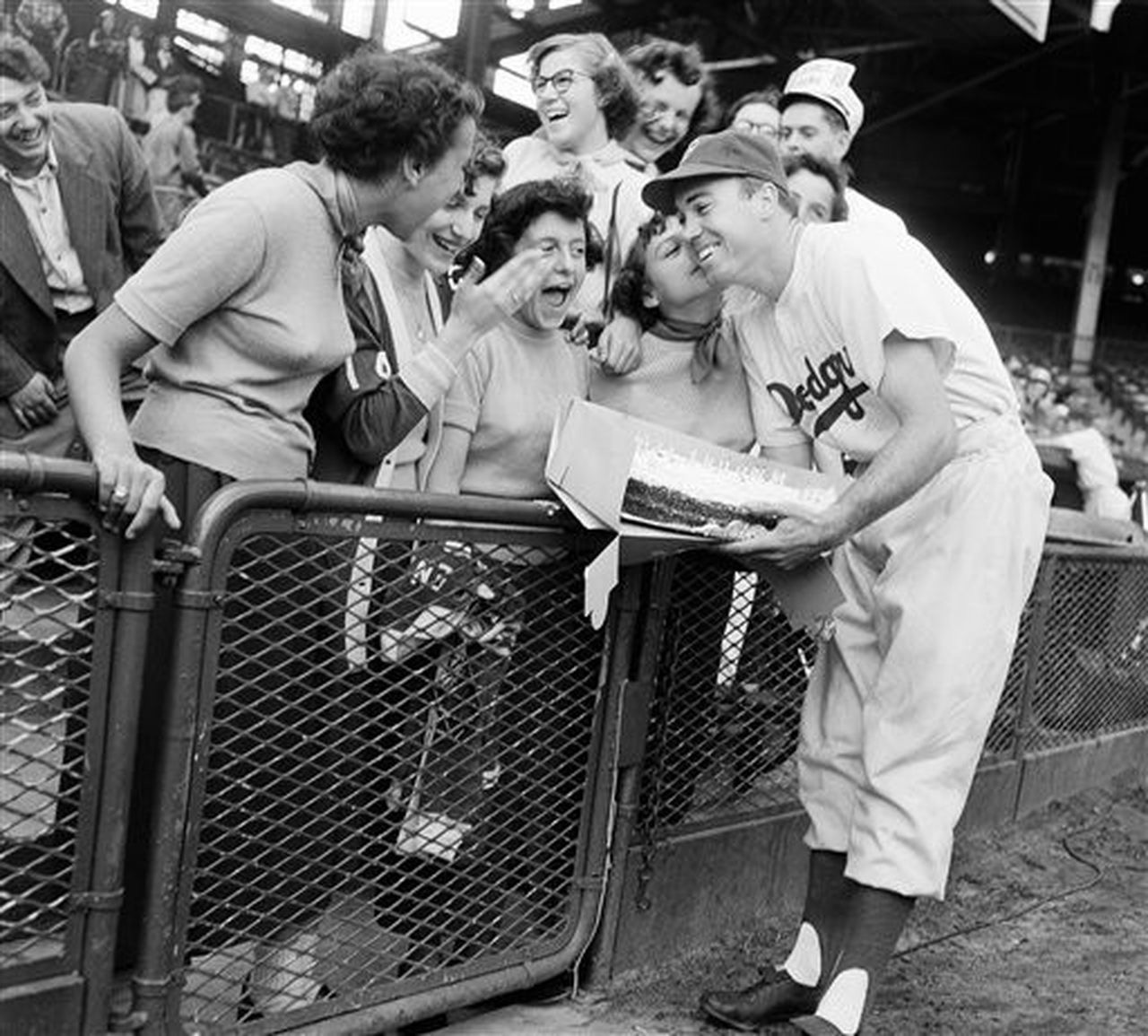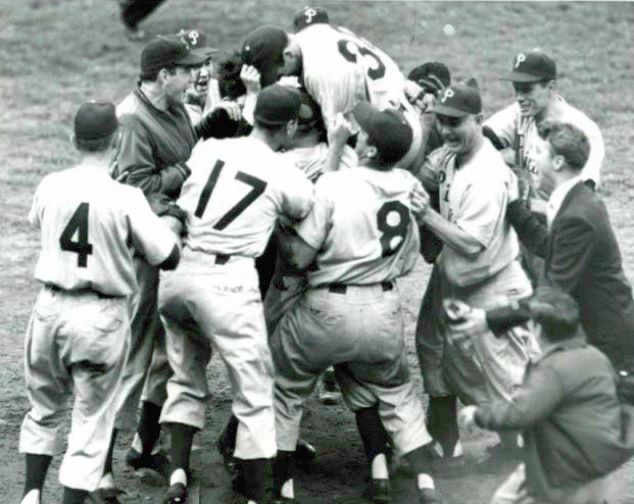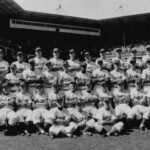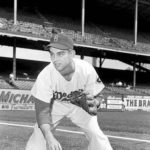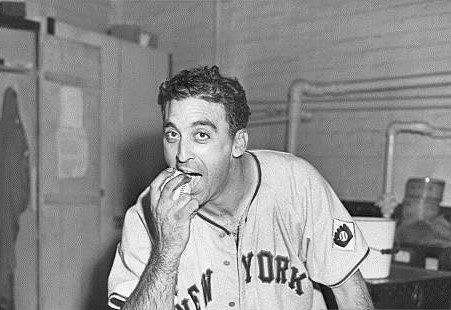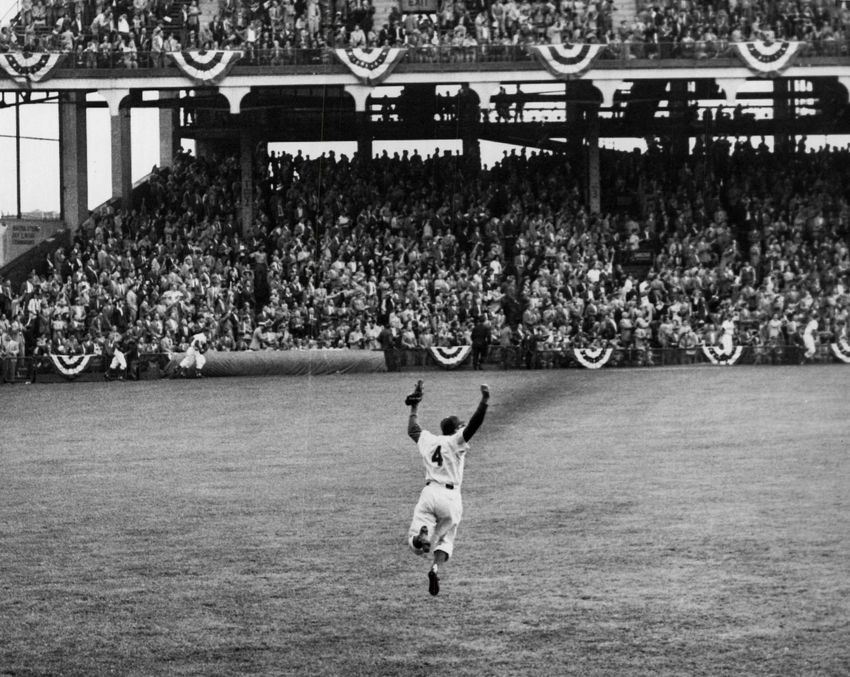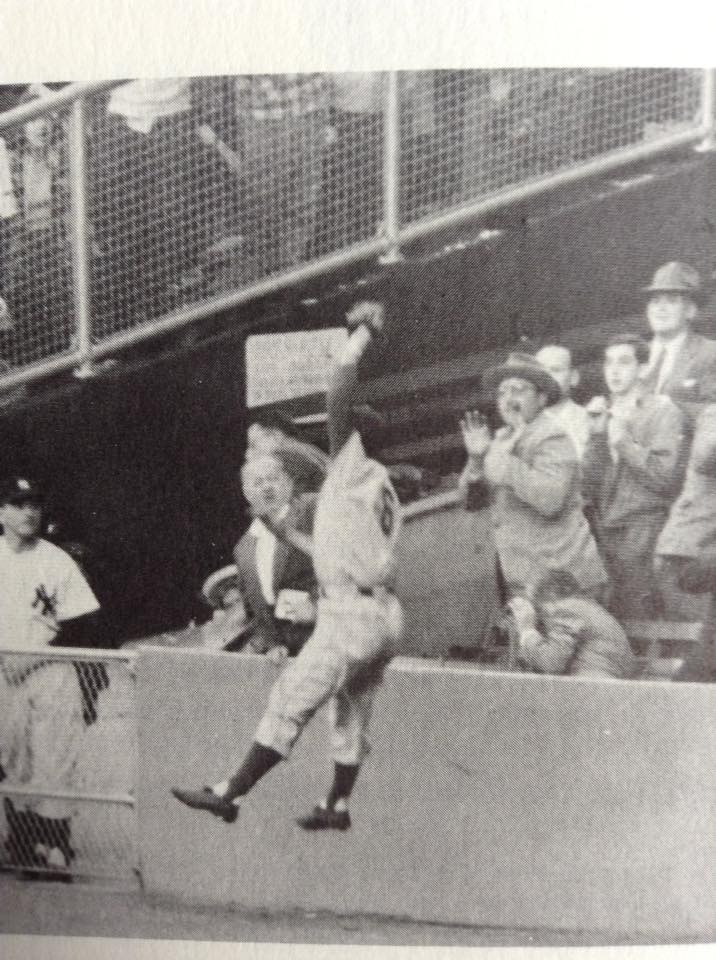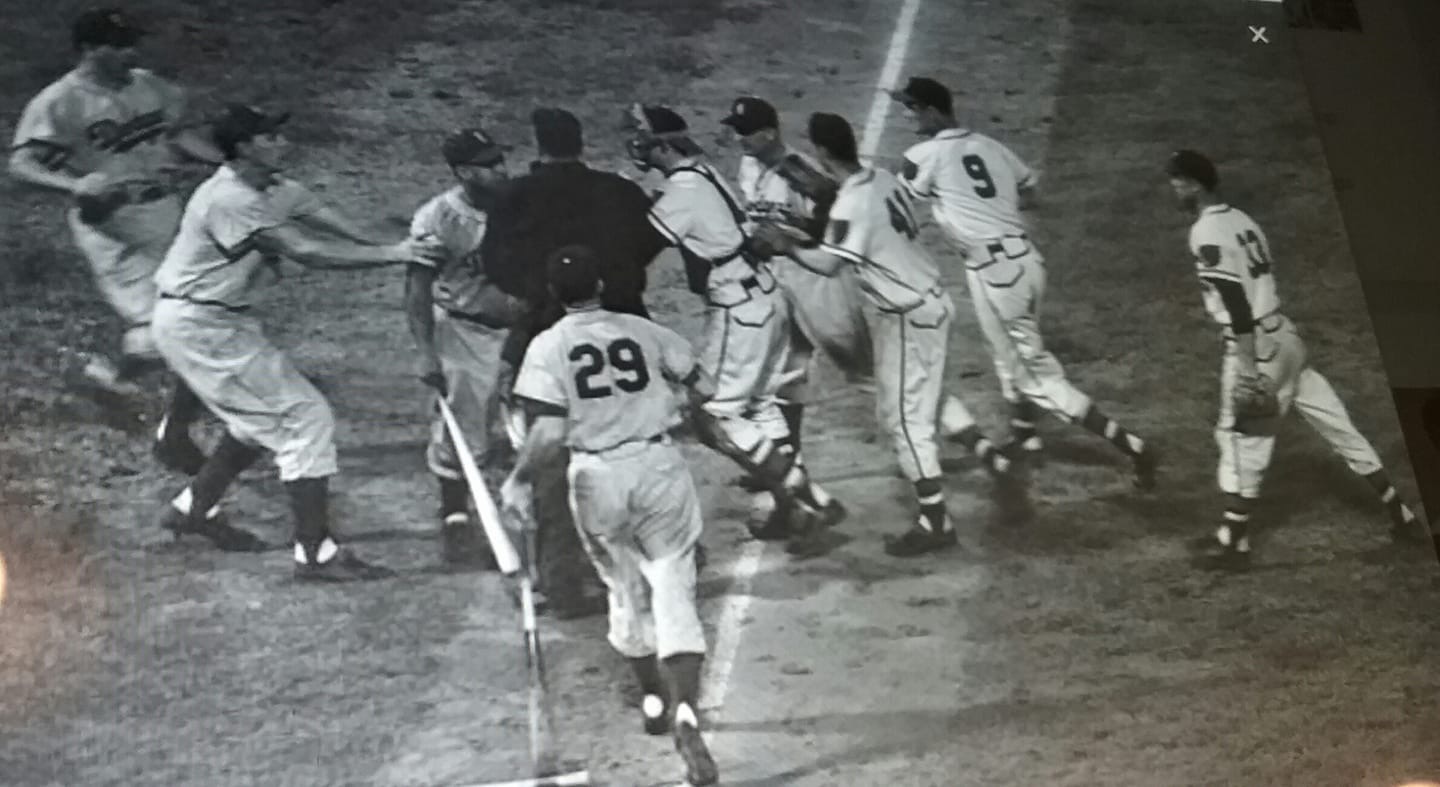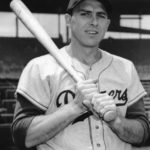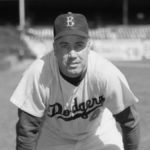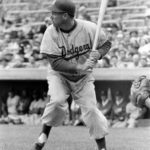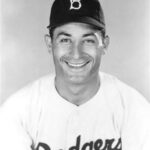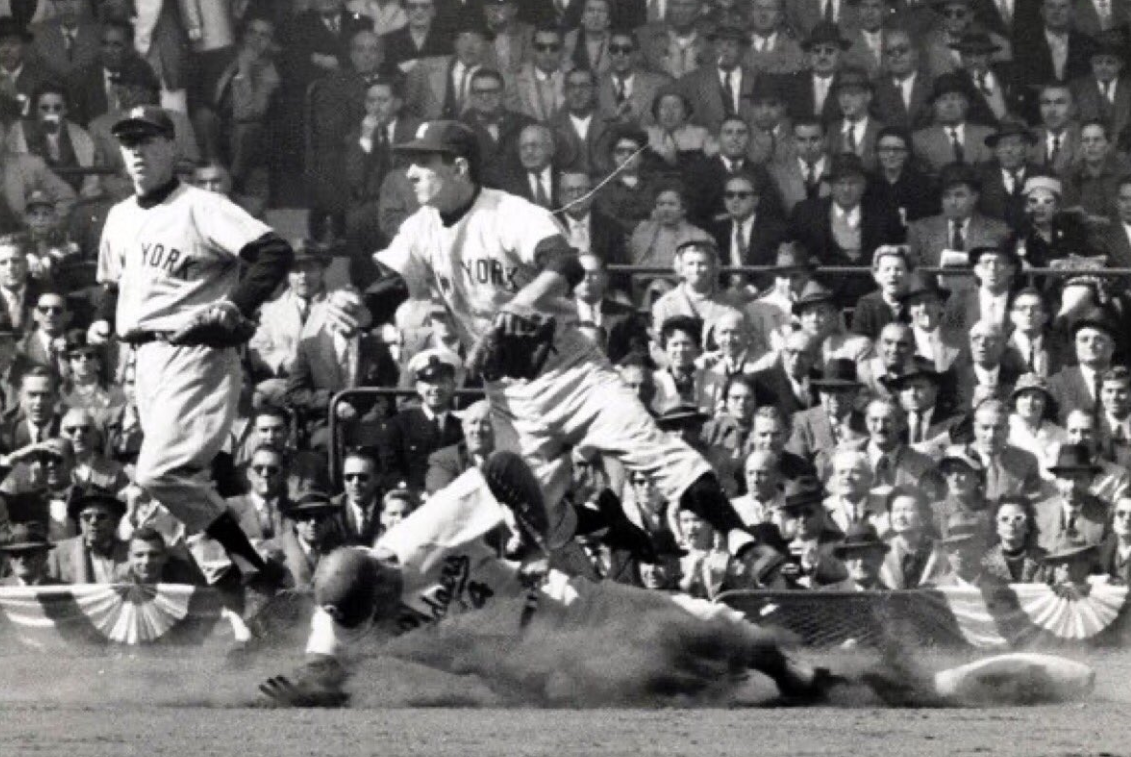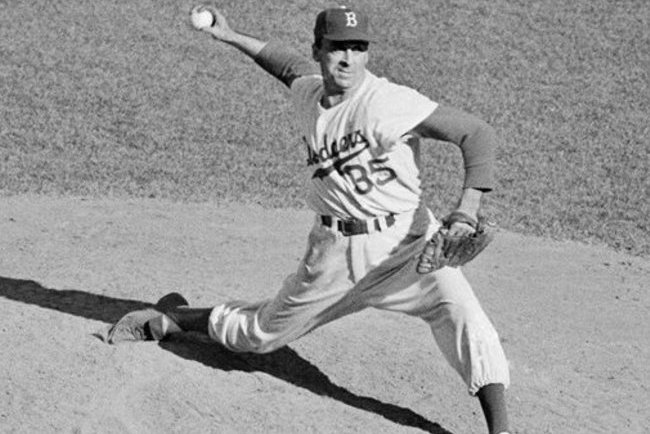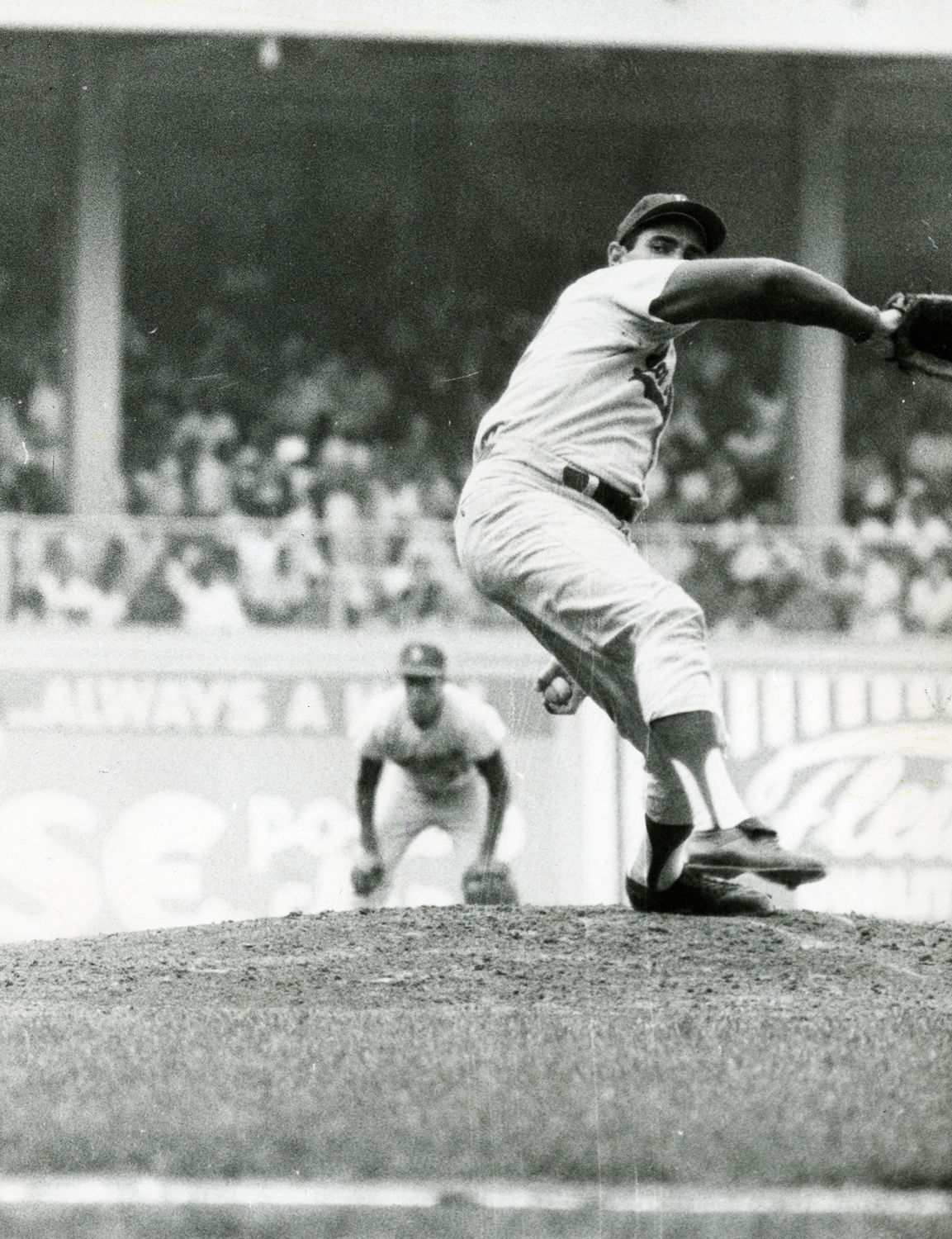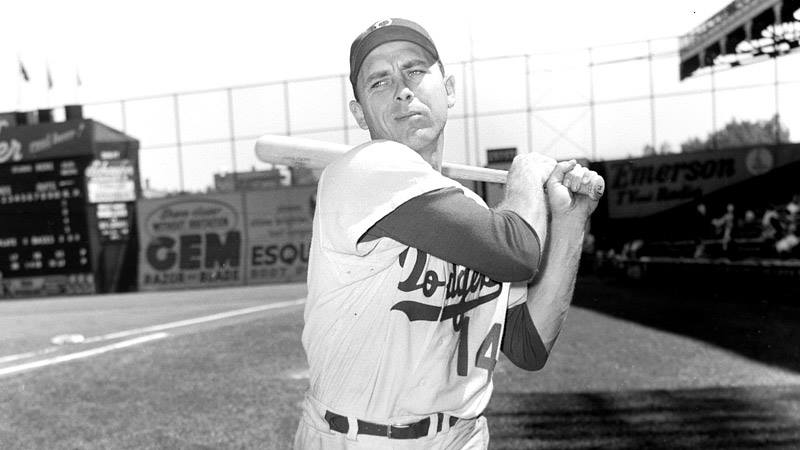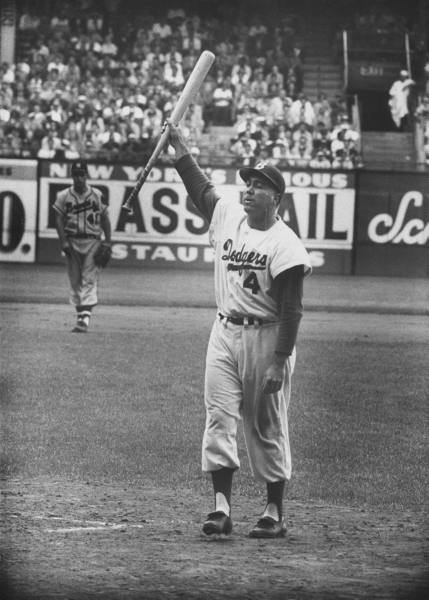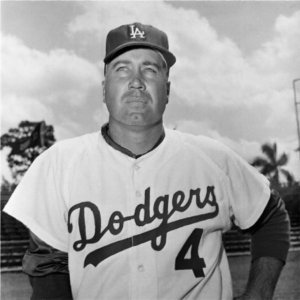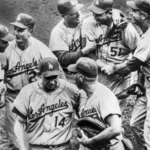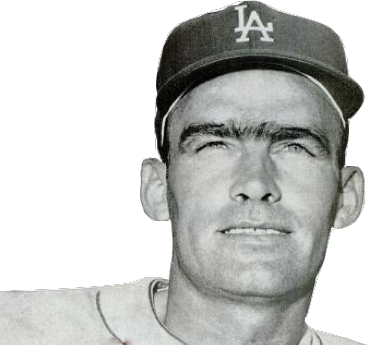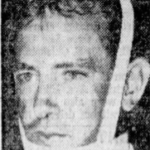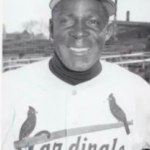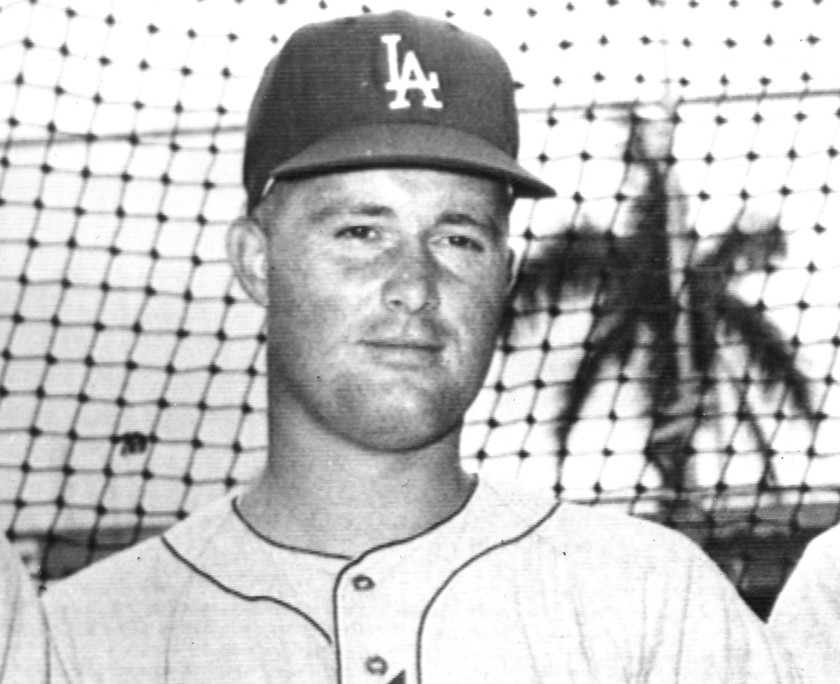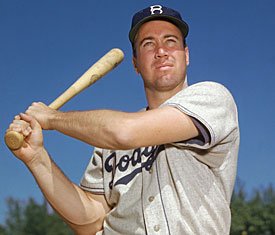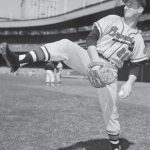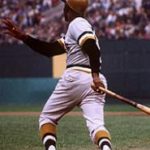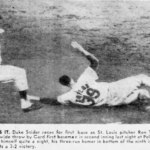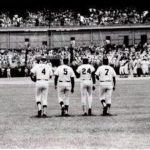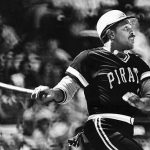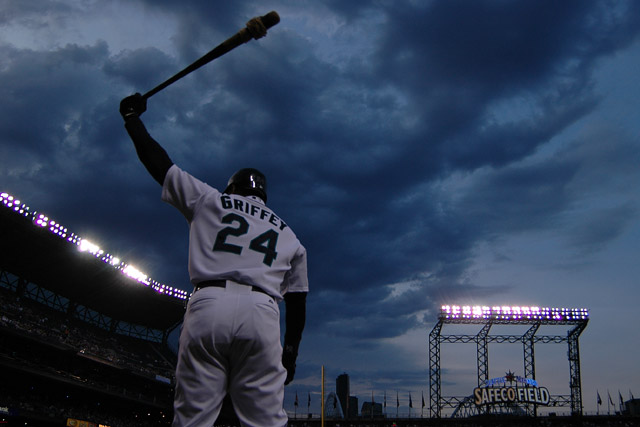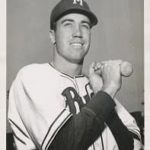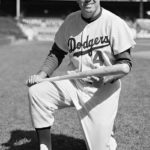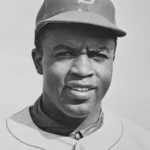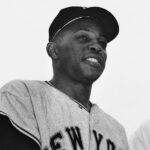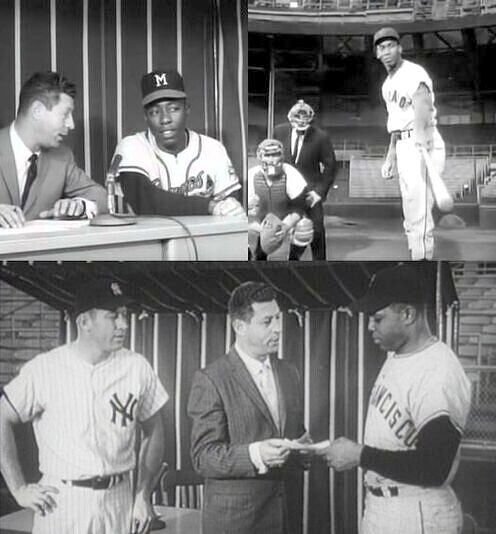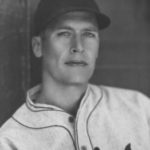Duke Snider
Position: Centerfielder
Bats: Left • Throws: Right
6-0, 179lb (183cm, 81kg)
Born: September 19, 1926 in Los Angeles, CA
Died: February 27, 2011 in Escondido, CA
Buried: Fallbrook Masonic Cemetery, Fallbrook, CA
High School: Compton HS (Compton, CA)
Debut: April 17, 1947 (10,310th in major league history)
vs. BSN 2 AB, 1 H, 0 HR, 0 RBI, 0 SB
Last Game: October 3, 1964
vs. CHC 1 AB, 1 H, 0 HR, 0 RBI, 0 SB
Hall of Fame: Inducted as Player in 1980. (Voted by BBWAA on 333/385 ballots)
View Duke Snider’s Page at the Baseball Hall of Fame (plaque, photos, videos).
Full Name: Edwin Donald Snider
Nicknames: The Silver Fox or Duke of Flatbush
View Player Info from the B-R Bullpen
View Player Bio from the SABR BioProject
Nine Players Who Debuted in 1947
Nellie Fox
Duke Snider
Larry Doby
Jackie Robinson
Curt Simmons
Mel Parnell
Vic Wertz
Ted Kluszewski
Ferris Fain
The Duke Snider Teammate Team
C: Roy Campanella
1B: Gil Hodges
2B: Jackie Robinson
3B: Arky Vaughan
SS: Maury Wills
LF: Frank Howard
CF: Willie Mays
RF: Carl Furillo
SP: Carl Erskine
SP: Don Newcombe
SP: Preacher Roe
SP: Sandy Koufax
RP: Joe Black
M: Walt Alston
Notable Events and Chronology for Duke Snider Career
His name immortalized by the phrase Willie, Mickey, and the Duke from the song Baseball, Dodger centerfielder Duke Snider was Brooklyn’s entry into one of the most passionate debates in baseball history. New York sportswriter Red Smith once wrote, “(Duke) Snider, (Mickey) Mantle, and (Willie) Mays. You could get a fat lip in any saloon by starting an argument as to which was the best.”
Sharing the big city spotlight with fellow future Hall of Fame centerfielders Willie Mays and Mickey Mantle, Snider was part of a magical period in New York baseball that saw a team from the nation’s largest city win the World Series in nine out of the 10 seasons between 1949 and 1958. The Dodgers appeared in the Fall Classic five times during that time, winning their only championship in Brooklyn in 1955. Although the Dodger lineup also featured other outstanding performers such as Jackie Robinson, Roy Campanella, and Gil Hodges throughout much of the period, no one on the team wielded a more potent bat than Snider. And, even though the Brooklyn centerfielder usually came out third best in comparisons to Mays and Mantle, Snider hit more home runs during the 1950s (326) than any other player in baseball.
Born on September 19, 1926 in Los Angeles, California, Edwin Donald Snider was an exceptional all-around athlete who excelled in both baseball and football at Compton High School in Southern California. After being spotted by one of Brooklyn Dodger executive Branch Rickey’s scouts, Snider signed an amateur free-agent contract with the Dodgers shortly after he graduated from high school in 1943. The young outfielder split the 1944 campaign between two Dodger farm teams, before spending all of 1945 in the United States Navy. Snider returned to the minors in 1946 and, after performing exceptionally well in each of the next two seasons, made brief appearances in Brooklyn in both 1947 and 1948.
Snider became the Dodgers’ regular centerfielder in 1949, hitting 23 home runs, driving in 92 runs, scoring 100 others, and batting .292 to help lead Brooklyn to the National League pennant. The Dodgers fell just short of capturing their second straight league championship the following year, but Snider earned the first of his seven consecutive selections to the All-Star Team. In addition to leading the league with 199 hits and 343 total bases, Duke placed among the leaders with 31 home runs, 107 runs batted in, 109 runs scored, and a .321 batting average.
Snider posted solid overall numbers again in 1951, but his batting average fell almost 50 points, to .277, and the Dodgers squandered a seemingly insurmountable 13-game lead to the Giants during the season’s final two months, eventually losing the pennant to their arch-rivals on Bobby Thomson’s famous Shot Heard ‘Round the World. Snider subsequently received much of the blame for his team’s failures in the New York newspapers, prompting the disgruntled outfielder to request a trade.
Snider later recalled, “I went to Walter O’Malley and told him I couldn’t take the pressure. I told him I’d just as soon be traded. I told him I figured I could do the Dodgers no good.”
The Dodger owner convinced Snider to remain in Brooklyn, and, after compiling good numbers again in 1952, the Dodger centerfielder established himself as one of the game’s elite players, stringing together the four most productive seasons of his career. Snider helped lead the Dodgers to their second straight pennant in 1953 by placing among the league leaders with 42 home runs, 126 runs batted in, and a .336 batting average, and topping the circuit with 132 runs scored and a .627 slugging percentage. He finished third in the league MVP balloting. Although Brooklyn failed to repeat as National League champions in 1954, Snider had another great year, hitting 40 homers, knocking in 130 runs, batting .341, and leading the league with 120 runs scored. The Dodgers won the pennant in each of the next two seasons, with Snider being their most potent offensive weapon. He hit 42 homers, batted .309, led the league with 136 runs batted in and 126 runs scored, and finished a close second in the MVP voting in 1955. The Duke of Flatbush then led the Dodgers to their only world championship in Brooklyn, hitting four home runs, knocking in seven runs, and batting .320 against the Yankees in the World Series. Snider previously homered four times against New York in the 1952 Fall Classic, thereby putting himself in the record books as the only player in history to accomplish the feat twice. Snider also had an exceptional year in 1956, driving in 101 runs, scoring 112 others, batting .292, and leading the league with 43 home runs, a .399 on-base percentage, and a .598 slugging percentage. Although Snider’s other numbers were not as impressive, he topped the 40-homer mark for the fifth consecutive time in 1957.
There is little doubt that the figures Snider compiled during his time in Brooklyn were aided immeasurably by the ballpark in which he played his home games. A noted bandbox, Ebbets Field was perfectly suited for Snider’s lefthanded power stroke. The slugger hit many balls over the short rightfield fence that might have been caught in other ballparks. Snider also benefited from batting third in Brooklyn’s predominantly righthanded hitting lineup. Surrounded by players such as Jackie Robinson, Roy Campanella, Gil Hodges, Carl Furillo, and Pee Wee Reese, each of whom swung from the other side of the plate, Snider rarely faced southpaw pitching, against which he struggled for much of his career. Nevertheless, Snider’s contributions to the dominant Dodger teams of the period cannot be overstated. More than just a home run hitter, he was a five-tool player who also possessed good speed and an outstanding throwing arm in the outfield. In discussing Snider’s fielding, Hall of Famer Ralph Kiner once noted, “I’d say Duke covers more ground, wastes less motion, and is more consistent than anyone since DiMaggio.” And Stan Musial named Snider, Willie Mays, and Hank Aaron as his all-time National League outfield.
The 1957 campaign was Snider’s last big year. The Dodgers moved to Los Angeles in 1958, and the combination of the Los Angeles Coliseum’s distant rightfield fence and injuries to the 32-year-old outfielder ended Snider’s days as a dominant home run hitter. He became a part-time player in his five remaining years with the Dodgers, never again hitting more than 23 home runs or driving in more than 88 runs in a season. Snider posted those numbers during the team’s 1959 championship campaign, giving him a resume that included appearances with six pennant-winning and two world championship teams. He returned to New York in 1963 to play for the Mets, then spent his final season back in California with the Giants. Snider retired at the end of 1964 with 407 career home runs, 1,333 runs batted in, 1,259 runs scored, and a .295 batting average. He led the National League in home runs, runs batted in, hits, walks, and on-base percentage once each, he finished first in slugging percentage twice, and he topped the circuit in runs scored and total bases three times each. In addition to topping 40 homers on five separate occasions, Snider surpassed 100 runs batted in and 100 runs scored six times each and batted over .300 seven times. He was selected to play in eight All-Star games. Snider finished in the top five in the league MVP voting three times, making it into the top ten on another three occasions. His 11 home runs and 26 RBIs in World Series play are both records for a National Leaguer.
After his playing career ended, Snider scouted for both the Dodgers and the Padres, and also briefly managed in the minor leagues before becoming an announcer for the Montreal Expos from 1973 to 1986. He was elected to the Baseball Hall of Fame by the members of the BBWAA in 1980.
@ET-DC@eyJkeW5hbWljIjp0cnVlLCJjb250ZW50IjoicG9zdF90YWdzIiwic2V0dGluZ3MiOnsiYmVmb3JlIjoiTGVhcm4gTW9yZSBhYm91dCB0aGUgdGVhbXMsIHBsYXllcnMsIGJhbGwgcGFya3MgYW5kIGV2ZW50cyB0aGF0IGhhcHBlbmVkIG9uIHRoaXMgZGF0ZSBpbiBoaXN0b3J5IC0gLSAtIC0gLSAtIC0gIiwiYWZ0ZXIiOiIiLCJsaW5rX3RvX3Rlcm1fcGFnZSI6Im9uIiwic2VwYXJhdG9yIjoiIHwgIiwiY2F0ZWdvcnlfdHlwZSI6InBvc3RfdGFnIn19@
Factoids, Quotes, Milestones and Odd Facts
Played For
Brooklyn Dodgers (1947-1957)
Los Angeles Dodgers (1958-1962)
New York Mets (1963)
San Francisco Giants (1964)
Similar: Reggie Smith, Ken Griffey Jr.
Linked: Al Kaline and Chuck Klein were inducted to the Hall of Fame with Snider in 1980… Mickey Mantle, Willie Mays
Best Season, 1956
Though his batting average dipped below .300, Snider still paced the National League in both slugging and OBP. He led in OPS, and blasted 43 homers. He scored and drove in 100 runs for the fourth straight season. The Dodgers won their fourth pennant in five years in 1956, yet Snider finished a disappointing 10th in the MVP voting for some reason.
Post-Season Appearances
1949 World Series
1952 World Series
1953 World Series
1955 World Series
1956 World Series
1959 World Series
Factoid
Duke Snider hit two home runs off Phillies’ ace Robin Roberts on September 22, 1957, the last homers ever hit in Brooklyn’s Ebbets Field.
Post-Season Notes
Snider is the only man in baseball history to twice hit four homers in a World Series. He did it in 1952 and 1955. He holds the NL record for most Series homers (11), and RBI (26).
Feats: Snider twice hit two home runs in a single World Sereis game, on October 6, 1952, and October 2, 1955. Each time he did it against the Yankees.
Notes
Snider finished in the top ten in MVP voting six times, but never won the award… The Sporting News named Snider the Major League Player of the Year in 1955 and selected him for its All-Star team in 1950 and 1952-1955… He was elected to the National Baseball Hall of Fame in 1980… Snider entered the final day of the season trailing Don Mueller .3426 to .3425, with Willie Mays at .3422. Mays collected three hits off Robin Roberts and won the title as Snider fell to third (.341).
Injuries and Explanation for Missed Playing Time
On April 23, 1958, Gil Hodges hit his 300th home run and Pee Wee Reese played his 2,000th game on the same day that Snider injured his arm before the game trying to throw a ball out of the Los Angeles Coliseum. Not impressed, the Dodgers’ front office fined Snider one day’s pay… On April 17, 1961, Snider hit his 370th career home run, moving him into 7th place on the all-time list. In that game Snider later suffered a broken elbow when he was hit by a Bob Gibson pitch
Hitting Streaks
27 games (1953)
27 games (1953)
22 games (1950)
22 games (1950)
Transactions
Before 1944 Season: Signed by the Brooklyn Dodgers as an amateur free agent; April 1, 1963: Purchased by the New York Mets from the Los Angeles Dodgers; April 14, 1964: Purchased by the San Francisco Giants from the New York Mets; October 6, 1964: Released by the San Francisco Giants.
Willie, Mickey and the Duke
For four seasons (1954-1957), Willie Mays, Mickey Mantle, and Duke Snider starred for their New York teams in center field. During that stretch, Snider hit more homers and drove in more runs than either of the other two celebrated stars.
Factoid
From 1947 to 1961, a span of 15 seasons, Duke Snider and Gil Hodges combined for 745 home runs, the fourth highest mark in baseball history by teammates.
Factoid
Duke Snider’s first two career homers came in the same game.
Home Run Facts
According to The Sporting News, Snider belted 16 home runs off relief pitchers who had just entered the game, good for second all-time when he retired. The record was held by Gil Hodges (17), but has probably been surpassed since Snider retired.
All-Star Selections
1950 NL
1951 NL
1952 NL
1953 NL
1954 NL
1955 NL
1956 NL
1963 NL
Replaced
Carl Furillo in center field, in 1949. (Furillo was moved to right.)
Replaced By
Joe Christopher
Best Strength as a Player
Power
Largest Weakness as a Player
Snider had no glaring weaknesses.
Other Resources & Links

